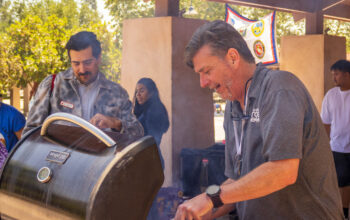Looking through a lens to capture emotion can bridge culture and highlight the human element.
Pierce College students, faculty and staff poured into the Great Hall Thursday as the Media Arts department continued its Speaker Series by hosting Los Angeles Times Photographer Marcus Yam.
Yam said he initially studied to become an Aerospace engineer, but his direction was altered once his talent in photography was discovered.
“I joined the school newspaper in my final year of college, and my photos ended up on the desk of the advisor for the paper,” Yam said. “He tracked me down and asked what I wanted to do with my life and if I would consider photography as a career.”
The newspaper advisor offered him an internship, and Yam said this experience was a revelation for him.
“In that moment, something clicked. The stars and planets began to align,” Yam said. “I knew this is what I was supposed to do for the rest of my life.”
Prior to the LA Times, Yam said he worked for the Seattle Times and as a freelance photographer.
“It taught me that life is fragile, and there are so many cultures,” Yam said. “It also taught me the value of quieting oneself and being sensitive to the culture and societal differences. We often impose our ideas of other people, but you learn to be quiet and understand how things work.”
Professor of Photography Rita Nisan said Yam has a good eye for photography and he showed fairness in the shots he took in Mosul.
“I liked the photos because they were interesting, eye-opening and human.” Nisan said. “He didn’t take sides and was kind to everybody. You could see it in the way he treated those in his pictures as real people as opposed to just subjects that fill the photos.”
Ryanchase Balthazar, communications, learned that the job of a photojournalist is more than just taking snapshots for the sake of constructing a story.
“I was surprised about how compassionate he was,” Balthazar said. “He captured people’s emotion, and he had a personal connection with the people he took the photos of. I always thought a photographer or journalist just tried to get the work done.”
Yam said photography helps describe moments without the use of words.
“It’s very much like writing,” Yam said. “There are pauses, commas, periods, paragraphs and more. It’s a complex, visual way of telling a story without having to read. You just look at it and have it capture you.”




